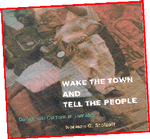
Title: Wake The Town And Tell The People: Dancehall Culture In Jamaica
Author: Norman C. Stolzoff
Reviewed By: Balford Henry
I loathe supporting another exposé on Jamaican music and culture written by a foreigner. But, at least, I have to admit that Norman C. Stolzoff's "Wake The Town And Tell The People: Dancehall Culture in Jamaica" is a genuine attempt to explain something we seemed to have overlooked.
Prophets are without honour in their own country and people tend to trivialise greatness when it is too familiar. For that reason we have failed to study our culture and its importance. So we have no one to blame but ourselves, when it is left to foreigners to define us for ourselves.
Attraction
Mr. Stolzoff was drawn to reggae music by reluctantly watching a Black Uhuru performance in his Los Angeles hometown. The first time he had heard the music was via a Bob Marley record:
"Frankly, I didn't like it, but what did I know? I was sixteen, a basketball junkie and I preferred talk radio to pop music," he said.
But, his older brother "thought it was cool" and, eventually, asked him to accompany him to the Black Uhuru performance.
The "charisma" of the group, lead by Michael Rose at that time, decked out in red and black leather suits, dreadlocks stuffed into their caps and "with the countenance of royalty", backed by the famous 'reggae twins', Sly & Robbie, converted him to reggae that very night.
Mr. Stolzoff said that reggae became a way of freeing himself from "the confines of middle class life in the suburbs of LA in the early 1980s".
"Reggae spoke to my sense of alienation, but not with the angst and anger of white music like punk or heavy metal", he admitted.
Eventually, he came was able to learn a lot about Jamaica from Professor Sylvia Wynter in Los Angeles, before travelling to the island and visiting the Accompong Maroon Town community, where he became acquainted with actual dancehall culture.
Nothing new
Nothing he writes is new to us who are directly connected to the phenomenon. In fact, it is general oral history and tradition. But, nevertheless we are indebted to him for his time and effort in putting together what must be, essentially, the most academic work on dancehall culture so far.
As a student and gentried person Mr. Stolzoff was able to spend a lot of time here since the mid-1990s researching dancehall music and culture. He was very close to Kilimanjaro, as well as other top sound systems, including Stone Love, during the period.
Challenge
He says that "Wake The Town and Tell The People" was conceived as a challenge to the prevailing view about dancehall culture:
"Dancehall has been widely misunderstood. For the most part, foreign music journalists and reggaeophiles have been the authoritative voice on Jamaican music outside Jamaica. The majority of these interpreters fell in love with reggae, as I did, for its rasta-inspired roots that is for its righteous lyrics of political protest, social uplift and spiritual liberation".
While dancehall music was being interpreted as decadent and nihilistic, Mr. Stolzoff found another perspective, one outside the centralisation of records and dubplates and which extended its roots into Jamaica's social and political and even its economic history and tradition.
Mr. Stolzoff found dancehall to be a "key cultural matrix and social institution" as well as "an important alternative economy", especially for the poor, "who are chronically unemployed or who want to avoid the rigors of minimum wage labour".
A very interesting and attractive book, it ought to be a watershed for how the music is studied in the future: As being much more than just music and dance and dubplates and deejays, but an intrinsic cultural force which has obviously influenced our society much more than many of us want to admit.
Publisher: Duke University Press



























